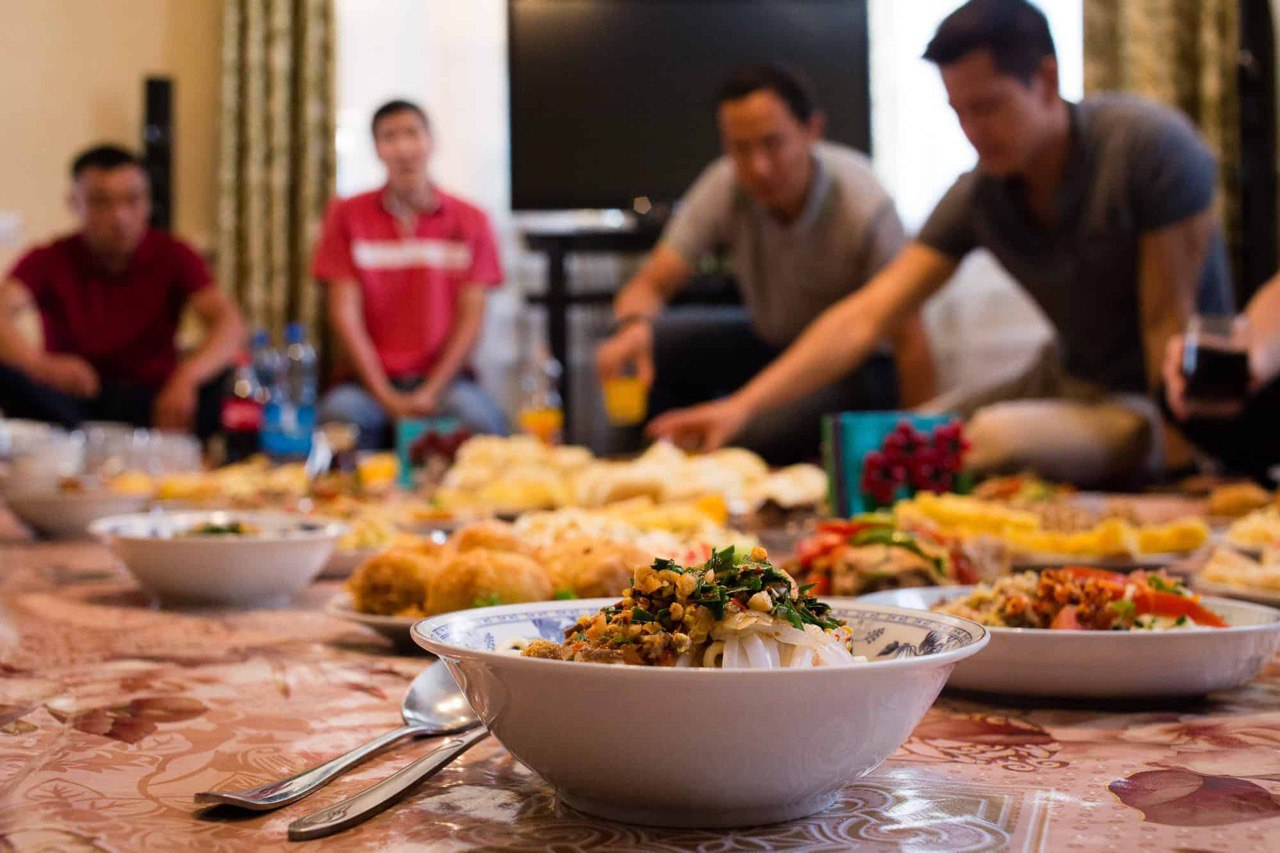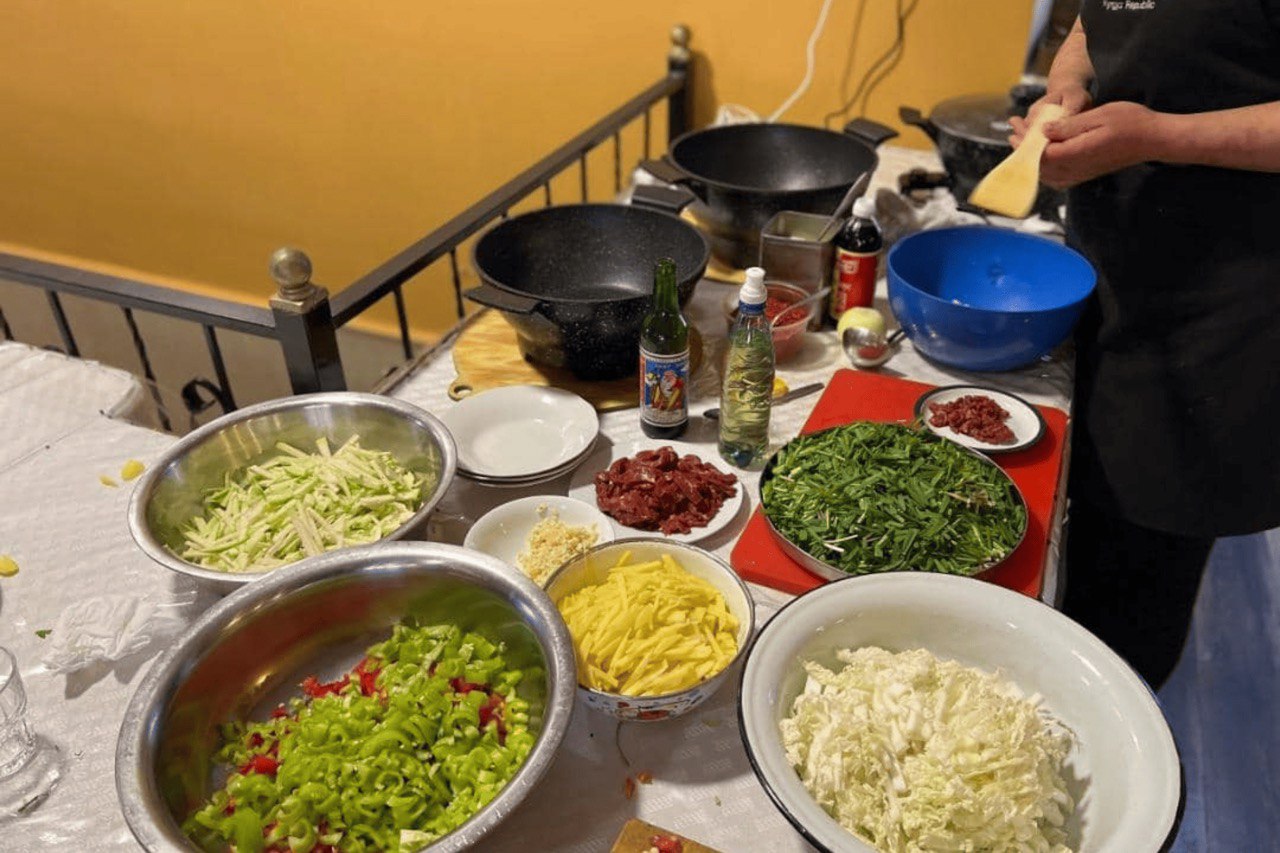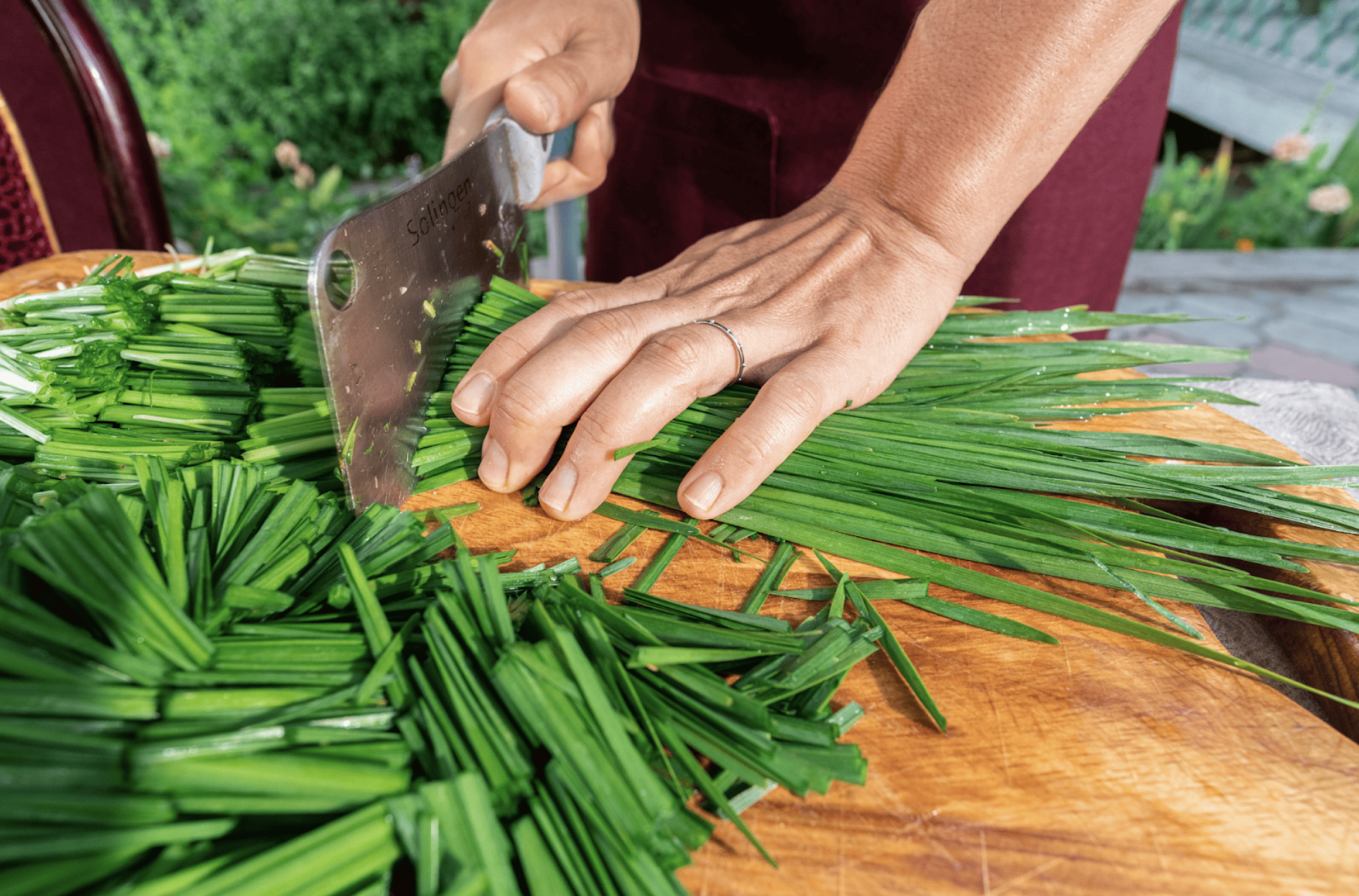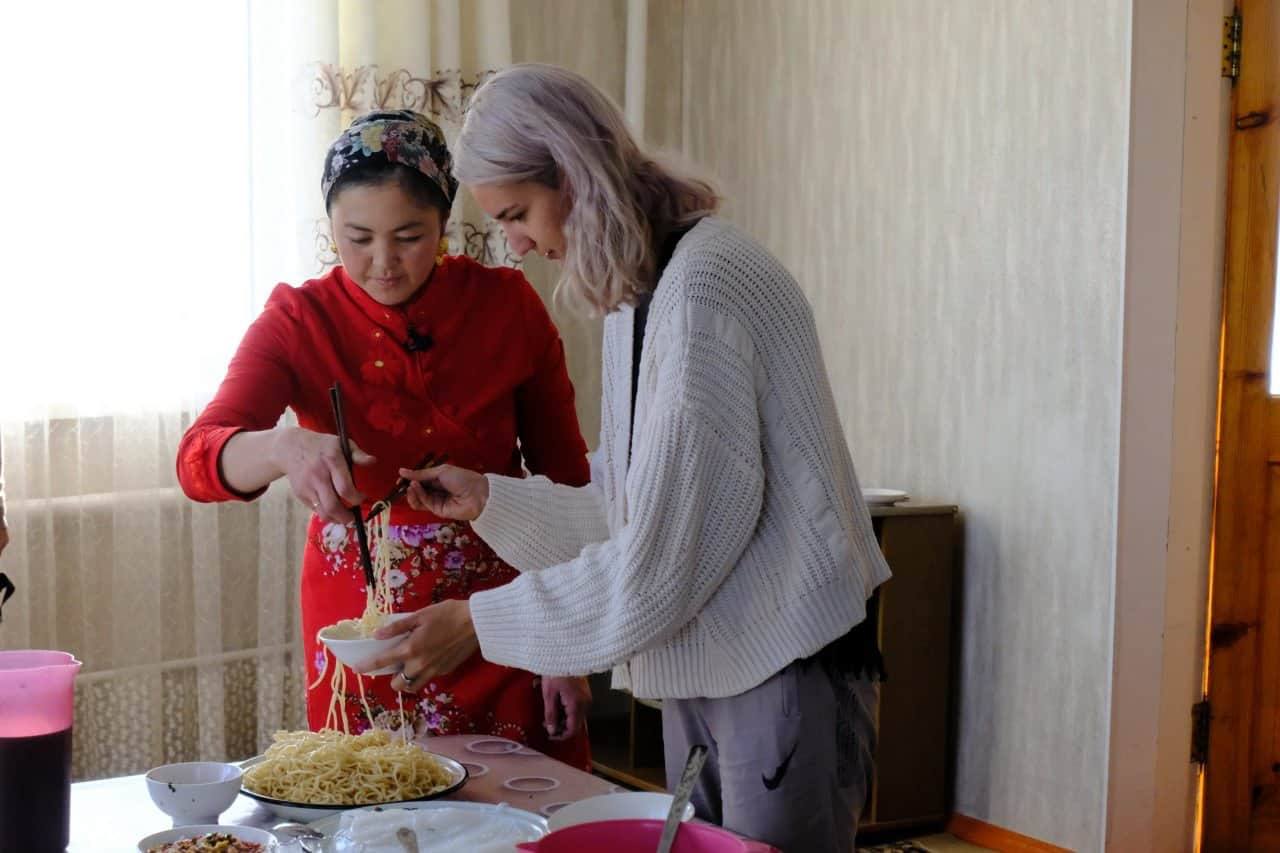Around 150 years ago, the Dungan people migrated from China to Central Asia. In 1862, this majority-Muslim ethnic group was struggling against the forced cultural assimilation promoted by the Han majority. This resulted in the Hui Rebellion, during which around 1 million Dungans were killed and more than 800 mosques were burned just in today’s Shaanxi and Gansu provinces.
For the following century, Dungans migrated in waves through the Tien Shan mountains, which mark the border between China and Central Asia. Today, around 100,000 Dungans (Huis) live in Central Asia, with around 60,000 in Kyrgyzstan, 30,000 in Kazakhstan, and 10,000 in Uzbekistan. In 1877, many Dungans settled in and around the eastern cities of Kyrgyzstan, such as Karakol and Irdyk. This was the starting point for the formation of the Dungan community in Central Asia, contributing to the society and culture in eastern Kyrgyzstan. Dungans also settled in a few smaller cities near Bishkek, such as Tokmok, Milanfan, Ivanovka, and Aleksandrovka.
As the Dungan people settled in Central Asia, they brought their culinary traditions with them. Dungan cuisine has since become relatively famous in both China and Central Asia, as it has adopted Chinese and Central Asian influences, while also sticking to its roots.
We talked to Madina Balakhisheva, a Dungan food expert offering tours and cooking classes in Karakol, a small town in eastern Kyrgyzstan with a population of around 90,000.
Food, Traveling Thousands of Miles
Balakhisheva said that the way Dungan food is cooked in Central Asia is quite similar to how it was done in China.
“The dish lanzhou niu rou mian (meaning “beef noodle soup”) has become very popular all over the world. Here, like in China, we cut all the ingredients into small pieces and fry them in a large fire,” Balakhisheva explained.
As a Muslim people, Dungans have some rules: the meat must be halal and they never eat pork.
“We have a dish consisting of eight bowls of tripe soup with eight different kinds of meatballs in each bowl. We usually fry some bread in oil and eat it along with this dish. What’s interesting though is the words for meatballs (wán zi) and fried bread (má huā zi) are the same in the Dungan and in Chinese,” Balakhisheva continued.
Despite 150 years and over 3,000 kilometers of separation from their old homeland, many Dungan customs remain.
When the border between Soviet Central Asia republics and China was shut, Dungan people struggled to access key ingredients. Balakhisheva explains that one of the biggest differences is that people in Karakol use fewer spices than in China.
“We only used two types of peppers: black pepper and red pepper powder. The black pepper came from India and the red pepper was planted by locals here. Both peppers have become an important part of modern Dungan cuisine. Today, we have many Chinese markets with plenty of spices. We started to incorporate them into our cooking, but we still don’t have as many as you would find in China,” Balakhisheva explained.
Chives have become a very important ingredient in Dungan cooking. But if you use chives in Central Asia, it likely shows a certain culinary influence.
“Ju ci (jiǔcài in Mandarin, or jusai in other Central Asian transliterations), or chives are very popular among Dungan people and anyone who has relations to China. But for those who don’t, it will be uncommon to see ju ci incorporated into their cuisine. We even eat it with bread and rice. We make many things with ju ci: baozi, jiaozi, and we use it in a sauce for laghman, so we really like it. It's a must-have ingredient in a Dungan cafe,” Balakhisheva noted.
The use of vinegar is another common indication of Chinese influence. Black vinegar, a sauce made of rice vinegar and soy sauce, is seen with most meals in China. Dungans in Central Asia use something similar.
“In our family when we are going to make manti (mántou), jiaozi, or baozi, we first need to see if we have vinegar (cù). If there is no cù, there is no baozi. First, we buy vinegar and then we make jiaozi or baozi,” Balakhisheva explained.
Fitting in with the New Neighbors
When Dungan food landed in Central Asia, it had to adapt to new palates and to a more restricted set of ingredients.
“There is quite a distinct Central Asian influence. You can see this in our famous dish, ashlyanfu. It used to just be called lyanfu; it was only made of starch, vinegar and a spicy sauce. But then people added some noodles and started calling it ashlyanfu. And now it’s a staple in Karakol,” Balakhisheva noted.
While Kyrgyz eating habits have made their way into Dungan dishes, Dungan recipes have also had the same effect.
“We brought our vinegar recipe from China; you can only find it in the Dungan communities around Issyk-Kul, since the climate is perfect for its production. In Bishkek, it’s too hot, and the vinegar can easily be spoiled. It’s a simple recipe, preserved for centuries from China, and consists of just three ingredients: bran, water, and leaven. The fermentation process is extremely rigorous, making it a trademark heritage of the Dungan people. Our vinegar has become such a critical ingredient in Karakol that you will find it used in restaurants and sold at markets no matter the cuisine - Russian, Tatar, Kyrgyz, or Dungan,” Balakhisheva told Vlast.
While some dishes remain distinctly Dungan or Kyrgyz, the heritage of some others is difficult to distinguish. While for example laghman is one of the most famous Dungan dishes, its origin is contested.
“Laghman is not just Dungan, it’s also Uyghur. People often ask me if Uyghur and Dungan Laghman are the same, and which cuisine this dish actually belongs to. Of course, both Dungans and Uyghurs say that they are the original makers of laghman. The two key differences are that we cook our vegetables separately and we typically serve laghman with many sauces,” Balakhisheva explained.
Dungan cuisine has done well to assimilate, making its way into many Kyrgyz restaurants and becoming household names.
“Ashlyanfu is identified as a Kyrgyz dish, although we have both Dungan and Kyrgyz ashlyanfu. So, you can see the Kyrgyz influence on our cuisine. Kyrgyz people are really big meat eaters, and since our arrival in Central Asia, we started putting meat in our dishes, and even in our sauces,” Balakhisheva said.
Another aspect of food culture that Dungans have adopted from the Kyrgyz is the tradition to pass out bread during the meal.
“Many Kyrgyz people call us vegetarians because we normally eat very little meat. But I would say that our cuisines influence one another, and I think this has helped bring us closer together.”
Passing Down Dungan Culture
Balakhisheva noted that it is challenging to educate their children about Dungan history, language, and culture. There are no Dungan schools in Karakol, and Dungan education has not been incorporated into the Kyrgyz curriculum.
Balakhisheva has found it to be a challenge passing down their language to her children.
Not unlike many other stateless ethnic groups, such as the Balochs, Wakhis, Pamirs, and Kurds, it remains an uphill battle to ensure Dungans are protected by the government.
“Around a year ago, a woman came to my hotel in Karakol. She was researching ethnic groups she believed would disappear. At first, I was frustrated. ‘What do you mean we are going to disappear? We are very alive here, we are not going to disappear,’ I said. But then when she started explaining her research, I understood how big of a problem this is,” Balakhisheva said.
“Even though both my husband and I speak the Dungan language, our children do not, and this contributes to the deterioration of our language,” she reflected.
A Growing Dungan Family
While there are legitimate fears over Dungans losing their footprint in Central Asia, Balakhisheva is actively working to promote Dungan food and culture. Through 'Destination Karakol', she leads Dungan food tours and cooking classes.
“People across Central Asia really like Dungan food, so you can even find them in Kyrgyz restaurants here in Karakol. While they still serve traditional Kyrgyz food, you will also find baozi, manti, and laghman there,” Balakhisheva said.
Balakhisheva recalls that more Dungans have come to Central Asia since the border between China and Kyrgyzstan opened in 1998. Many Chinese students have also come to open restaurants.
“Today, there’s a very popular restaurant in Bishkek called Kuldja, and most people who work there are from China. Who knows, perhaps it will have an impact on the development of Dungan gastronomy,” Balakhisheva explained.
Also since the border reopened, Chinese shops and markets have begun sprouting up again in Karakol, selling key ingredients that would be otherwise hard to find.
Chinese stores also sell ground red pepper. But Balakhisheva always prefers to buy it from Dungan producers in Tokmok, because, as she explained, the pepper grows better in hot weather.
The opportunity for Dungans in Karakol to purchase wheat vinegar and red pepper powder has helped authentic Dungan flavors last in Karakol, uplifting Dungan people and Balakhisheva's Dungan food tours.
Dungans across Central Asia all originally came from China, but their food has adapted overtime, each slightly differently based on where they ended up.
“Each style of Dungan food has its own distinct characteristics. Here in Karakol it could be because we are relatively isolated, allowing our traditions to last longer. The process to prepare Dungan dishes is very labor-intensive and it’s common that people will try to simplify it. But all these are ancient traditions,” Balakhisheva said.
Note: the article was amended to reflect that the interviewee's last name is Balakhisheva, while Sabyrovna (previous version) is her patronymic.
Поддержите журналистику, которой доверяют.











